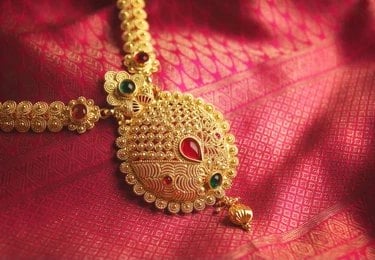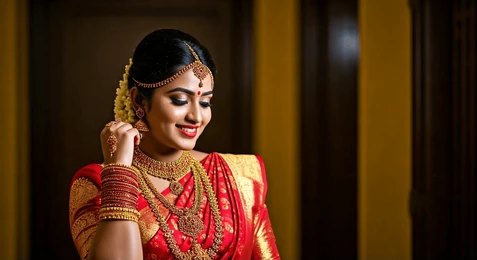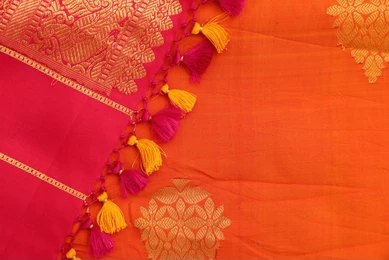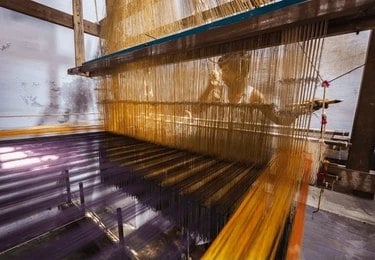How to Identify Pure Kanjivaram Silk Saree - Your Complete Guide
LIFESTYLE

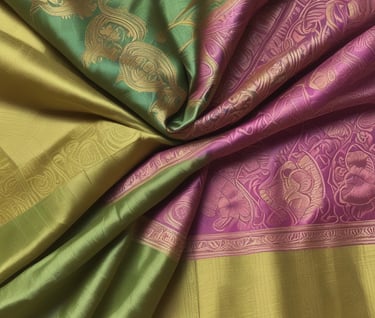
Kanjivaram silk sarees are more than just elegant attire—they are cultural heirlooms. Originating from the sacred town of Kanchipuram in Tamil Nadu, these sarees represent the rich traditions, artistry, and grandeur of South India. However, as demand surges and replicas flood the market, distinguishing an authentic Kanjivaram saree has become a refined skill.
Whether you're purchasing your first or adding to a cherished collection, this guide offers a comprehensive look at how to spot a true Kanjivaram silk saree—from texture and motifs to in-store questions and at-home tests.
Table of Contents
The Story Behind Kanjivaram Silk
What Makes a Kanjivaram Saree So Special?
Key Markers of Authentic Kanjivaram Silk
Tactile & Visual Tests: Feel, Weight, and Drape
Zari: The Golden Thread Test
The Burn Test: A Last-Resort Method
Traditional Motifs and What They Mean
Understanding Weaving Techniques: Korvai, Body-Pallu Join, and More
How to Read a Silk Mark Certification
Buying Online? Red Flags and Smart Habits
How to Spot a Powerloom or Fake Silk Copy
Expert Tips from Weavers & Heritage Sellers
Final Thoughts: Buying with Confidence
1. The Story Behind Kanjivaram Silk - How to Identify a Pure Kanjivaram Silk Saree
With a history spanning over four centuries, the tale of Kanjivaram silk is deeply connected to the migration of the Devanga and Saligar weaver communities. These artisans were invited by the Vijayanagara kings to settle in Kanchipuram and contribute to its weaving culture. Inspired by temple sculptures and Dravidian architecture, they began incorporating religious narratives and symbolic motifs into their designs.
Designs often reflect stories from Hindu epics such as the Ramayana and Mahabharata, featuring figures like peacocks, mythical creatures like the yali, and celestial themes. Over time, these sarees evolved beyond religious use, becoming staples at weddings, festivals, and formal occasions.
Crafting a single saree can take anywhere from 10 to 20 days, depending on its complexity. The entire process, from preparing the loom to dyeing yarn and weaving intricate patterns, is done by hand, preserving ancestral techniques passed down through generations.
2. What Makes a Kanjivaram Saree So Special? - How to Identify a Pure Kanjivaram Silk Saree
The magic of a Kanjivaram saree lies in its material, craftsmanship, and cultural roots. It begins with pure mulberry silk, renowned for its strength and natural gloss. Sourced meticulously, this silk is chosen for its long fibers and lasting durability.
The zari—a hallmark of luxury—is crafted by coating silver threads with gold and wrapping them around silk yarn. Unlike synthetic alternatives, pure zari retains its sheen and resists tarnishing over time, lending the saree a timeless glow.
One standout feature is the Korvai weaving technique. In authentic sarees, the body, border, and pallu are woven separately and joined using a careful interlocking method. These sarees are further adorned with motifs rooted in local traditions and religious symbolism, making each piece a wearable tapestry of culture.
3. Key Markers of Authentic Kanjivaram Silk - How to Identify a Pure Kanjivaram Silk Saree
To identify a true Kanjivaram saree, focus on several defining elements. Firstly, authentic silk is both soft and crisp, with a distinct shine that isn’t overly glossy. Unlike synthetic silk, it won’t slip easily and carries a heavier weight due to the thickness of the silk yarn and zari.
Pure zari is another indicator. It’s made from silver and gold, and a simple scratch test can help: gently rub the zari and check for a silver base. Fakes often reveal a copper or reddish core.
The Korvai technique—where contrasting pallu and borders are manually joined—creates a visible ridge. Machine-made sarees generally lack this feature. Also, an authentic piece usually bears a Silk Mark tag, confirming the silk’s purity and quality.
4. Tactile & Visual Tests: Feel, Weight, and Drape
Authentic Kanjivaram silk stands out through texture and appearance. The fabric feels slightly coarse yet smooth, producing a rustling sound often described as the "music of silk." This sets it apart from overly smooth synthetic fabrics.
Weight is another telltale sign. Genuine sarees are heavier, often weighing between 600 grams and over a kilogram, depending on the intricacy of the weave. This heft helps maintain the saree’s structure and pleats beautifully when draped.
A pure Kanjivaram drapes in a way that enhances the wearer’s silhouette, offering a structured look. Synthetic or blended versions tend to collapse or cling unnaturally, failing to deliver the same grace.
5. Zari: The Golden Thread Test
Zari work defines the regal charm of Kanjivaram sarees. Traditional zari is made from a silver base coated with gold and woven around silk threads to form rich borders and motifs.
To test authenticity, lightly scratch a hidden portion of the zari. If it exposes a silver hue underneath, it’s likely pure. If it reveals a reddish or brassy core, it’s probably imitation.
Authentic zari has a soft glow and doesn't wear off easily. In contrast, synthetic versions tend to fade, feel rough, and break down over time. Investing in real zari ensures your saree maintains its brilliance for generations.
6. The Burn Test: A Last-Resort Method
The burn test is a traditional, though risky, way to confirm real silk. Burning a small loose thread can reveal its nature: pure silk smells like burnt hair and leaves a soft ash, while synthetics smell like plastic and melt into a hard bead.
This method should be used sparingly and with extreme caution, preferably with the seller’s consent and on an unnoticeable thread. Also, blended fabrics may yield mixed results, so rely on this test only when other methods fall short.
7. Traditional Motifs and What They Mean - How to Identify a Pure Kanjivaram Silk Saree
Motifs on Kanjivaram sarees are steeped in meaning, often inspired by mythology, temple architecture, and nature. These designs reflect spiritual and cultural significance, adding depth to the saree’s beauty.
Common motifs include:
Mayil (peacock): Symbol of elegance and divine beauty
Annapakshi (mythical swan): Represents purity and wisdom
Thazhampoo Rekku (temple border): Echoes the form of temple towers, signifying sanctity
Yali: A hybrid creature symbolizing power and protection
Chakram (wheel) and Rudraksha (holy bead): Evoke spiritual focus and balance
Understanding these patterns allows buyers to appreciate the cultural craftsmanship that sets each saree apart.
8. Understanding Weaving Techniques: Korvai, Body-Pallu Join, and More
A true Kanjivaram saree showcases time-honored weaving techniques, executed entirely by hand. The Korvai method stands out—here, the body, border, and pallu are woven separately and then interlocked, creating a noticeable ridge where they meet.
Another key feature is the three-shuttle method, especially for contrasting designs. Each shuttle carries a different thread color, requiring precise manual coordination by the weaver.
Authentic sarees also use double warp and double weft weaving, adding density and durability. The pallu may even be woven on a separate warp, ensuring intricate detailing. These methods offer visual cues of authenticity and unmatched craftsmanship.
9. How to Read a Silk Mark Certification - How to Identify a Pure Kanjivaram Silk Saree
The Silk Mark tag, issued by the Silk Mark Organisation of India (SMOI), is a crucial authenticity marker. This certification verifies that the saree is made from 100% pure silk.
Key features include:
A unique serial number for verification
A scannable QR code linking to product details
A tamper-evident hologram
The official Silk Mark logo
Some sellers may also provide supplementary certificates or reports. However, remember that the Silk Mark guarantees only the purity of the silk, not the zari. For complete assurance, confirm details about both the silk and the zari from your seller.
10. Buying Online? Red Flags and Smart Habits - How to Identify a Pure Kanjivaram Silk Saree
While online platforms provide access to diverse collections, they also carry risks of fraud. To shop safely, watch for the following signs:
Red Flags:
Prices significantly lower than standard (e.g., "pure" Kanjivarams for ₹2,000–₹5,000)
Vague or misleading product descriptions using terms like "Kanchi-style" or "art silk"
Low-quality images and no return policy
Smart Habits:
Request close-up videos or images of the saree’s details
Ask for proof of Silk Mark certification
Choose reputed platforms like Taneira, Nalli, or Co-optex
Verify seller credibility by reading reviews and checking for artisan stories
11. How to Spot a Powerloom or Fake Silk Copy - How to Identify a Pure Kanjivaram Silk Saree
Mass-produced sarees often mimic real Kanjivarams but lack depth and character. Here’s how to identify them:
Powerloom Sarees:
No Korvai join; borders and body blend seamlessly
Repetitive, machine-perfect motifs
Fake Silk:
Feels unnaturally smooth and slippery
Reflects a harsh, plastic-like shine
Drapes poorly, clinging instead of holding structure
Zari looks overly shiny and fades quickly
12. Expert Tips from Weavers & Heritage Sellers - How to Identify a Pure Kanjivaram Silk Saree
Insights from those closest to the craft can guide your purchase:
"Ask detailed questions": A knowledgeable seller will happily share stories behind the motifs and techniques.
"Feel the weight": Authentic sarees are heavier and drape with authority.
"Beware of deep discounts": Real handloom and zari work come with a fair cost.
Final Thoughts
Purchasing a Kanjivaram saree is more than a transaction—it’s a celebration of heritage. When you understand the signs of authenticity—from tactile feel and weaving techniques to spiritual motifs and certifications—you can buy with assurance and pride.
Whether for a wedding, a festival, or personal collection, approach your saree with respect and curiosity. A genuine Kanjivaram doesn’t just add elegance to your wardrobe—it becomes part of your story, a legacy to be treasured and passed down.

